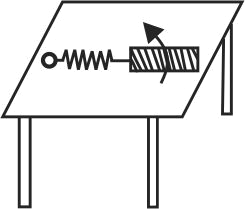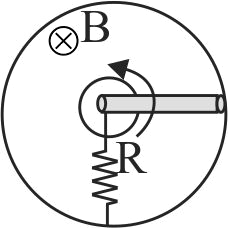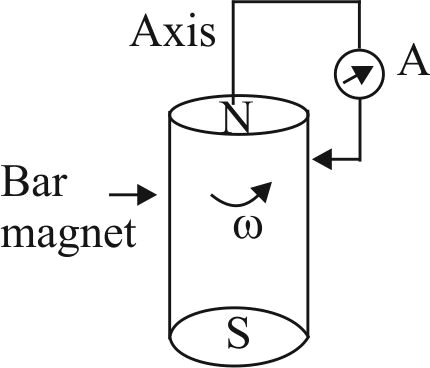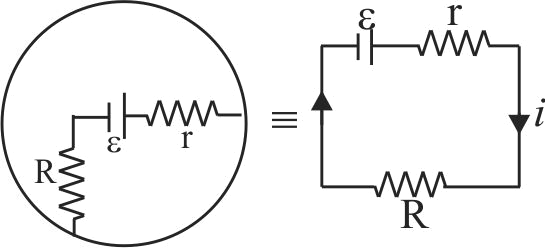358444
A metallic rod of length ' \(l\) ' is tied to a string of length \(2 l\) and made to rotate with angular speed \(\omega\) on a horizontal table with one end of the string fixed . If there is a vertical magnetic field ' \(B\) ' in the region, the e.m.f. induced across the ends of the rod is :
358445 A metal conductor of length \(2\;m\) rotates vertically about one of its ends at an angular velocity of \(50\,rad{\rm{/}}\sec \). If the horizontal component of earth's magnetic field is \(0.5\;T\), then the \(E M F\) developed between the two ends of conductor.
358448
A rod of length \(L\) and resistance \(r\) rotates about one end as shown in figure. Its other end touches a conducting ring of negligible resistance. A resistance \(R\) is connected between centre and periphery. Find the current in the resistance \(R\). There is a uniform magnetic field \(\mathrm{B}\) directed as shown.
358444
A metallic rod of length ' \(l\) ' is tied to a string of length \(2 l\) and made to rotate with angular speed \(\omega\) on a horizontal table with one end of the string fixed . If there is a vertical magnetic field ' \(B\) ' in the region, the e.m.f. induced across the ends of the rod is :
358445 A metal conductor of length \(2\;m\) rotates vertically about one of its ends at an angular velocity of \(50\,rad{\rm{/}}\sec \). If the horizontal component of earth's magnetic field is \(0.5\;T\), then the \(E M F\) developed between the two ends of conductor.
358448
A rod of length \(L\) and resistance \(r\) rotates about one end as shown in figure. Its other end touches a conducting ring of negligible resistance. A resistance \(R\) is connected between centre and periphery. Find the current in the resistance \(R\). There is a uniform magnetic field \(\mathrm{B}\) directed as shown.
358444
A metallic rod of length ' \(l\) ' is tied to a string of length \(2 l\) and made to rotate with angular speed \(\omega\) on a horizontal table with one end of the string fixed . If there is a vertical magnetic field ' \(B\) ' in the region, the e.m.f. induced across the ends of the rod is :
358445 A metal conductor of length \(2\;m\) rotates vertically about one of its ends at an angular velocity of \(50\,rad{\rm{/}}\sec \). If the horizontal component of earth's magnetic field is \(0.5\;T\), then the \(E M F\) developed between the two ends of conductor.
358448
A rod of length \(L\) and resistance \(r\) rotates about one end as shown in figure. Its other end touches a conducting ring of negligible resistance. A resistance \(R\) is connected between centre and periphery. Find the current in the resistance \(R\). There is a uniform magnetic field \(\mathrm{B}\) directed as shown.
358444
A metallic rod of length ' \(l\) ' is tied to a string of length \(2 l\) and made to rotate with angular speed \(\omega\) on a horizontal table with one end of the string fixed . If there is a vertical magnetic field ' \(B\) ' in the region, the e.m.f. induced across the ends of the rod is :
358445 A metal conductor of length \(2\;m\) rotates vertically about one of its ends at an angular velocity of \(50\,rad{\rm{/}}\sec \). If the horizontal component of earth's magnetic field is \(0.5\;T\), then the \(E M F\) developed between the two ends of conductor.
358448
A rod of length \(L\) and resistance \(r\) rotates about one end as shown in figure. Its other end touches a conducting ring of negligible resistance. A resistance \(R\) is connected between centre and periphery. Find the current in the resistance \(R\). There is a uniform magnetic field \(\mathrm{B}\) directed as shown.
358444
A metallic rod of length ' \(l\) ' is tied to a string of length \(2 l\) and made to rotate with angular speed \(\omega\) on a horizontal table with one end of the string fixed . If there is a vertical magnetic field ' \(B\) ' in the region, the e.m.f. induced across the ends of the rod is :
358445 A metal conductor of length \(2\;m\) rotates vertically about one of its ends at an angular velocity of \(50\,rad{\rm{/}}\sec \). If the horizontal component of earth's magnetic field is \(0.5\;T\), then the \(E M F\) developed between the two ends of conductor.
358448
A rod of length \(L\) and resistance \(r\) rotates about one end as shown in figure. Its other end touches a conducting ring of negligible resistance. A resistance \(R\) is connected between centre and periphery. Find the current in the resistance \(R\). There is a uniform magnetic field \(\mathrm{B}\) directed as shown.


